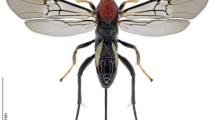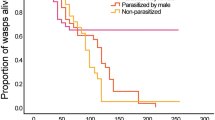Abstract
PREVIOUS experimental infestations of Chironomus tentans larvae with the nematode Paramermis contorta confirmed that crowding plays a major part in determining the sex of the parasites1. Observations by Caullery and Comas2 on natural populations showed that an increase of the degree of infestation results in an increase of the relative frequency of the males of Paramermis. It was also established that, at a given degree of infestation, the relative frequency of male Paramermis decreases with the increasing lengths of the Chironomus larvae at the moment when they are penetrated by the nematode3.
This is a preview of subscription content, access via your institution
Access options
Subscribe to this journal
Receive 51 print issues and online access
$199.00 per year
only $3.90 per issue
Buy this article
- Purchase on Springer Link
- Instant access to full article PDF
Prices may be subject to local taxes which are calculated during checkout
Similar content being viewed by others
References
Parenti, U., Arch. Zool., 47, 209 (1962).
Caullery, M., and Comas, M., C. R. Acad. Sci., Paris, 186, 646 (1928).
Parenti, U., Boll. Zool., 29, 453 (1962).
Author information
Authors and Affiliations
Rights and permissions
About this article
Cite this article
PARENTI, U. Male and Female Influence of Adult Individuals on Undifferentiated Larvae of the Parasitic Nematode Paramermis contorta. Nature 207, 1105–1106 (1965). https://doi.org/10.1038/2071105b0
Published:
Issue Date:
DOI: https://doi.org/10.1038/2071105b0
This article is cited by
-
Labile Sex Expression and the Evolution of Dioecy in Ophryotrocha Polychaete Worms
Evolutionary Biology (2015)
-
Sex ratio and sex change in wild and laboratory populations ofTyposyllis prolifera (Polychaeta)
Marine Biology (1986)
Comments
By submitting a comment you agree to abide by our Terms and Community Guidelines. If you find something abusive or that does not comply with our terms or guidelines please flag it as inappropriate.



